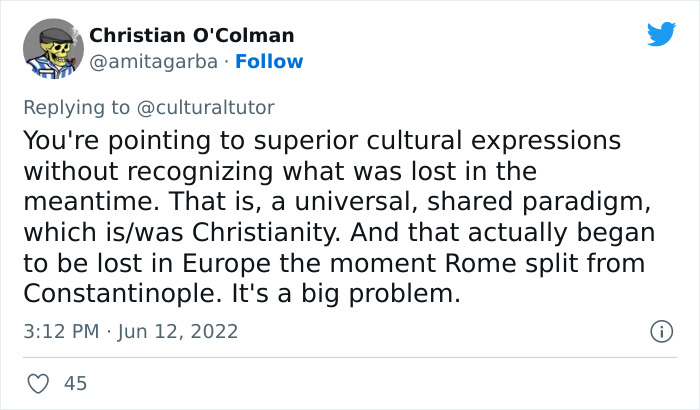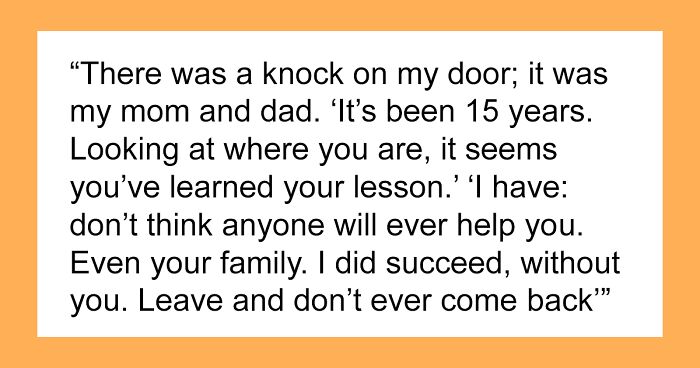
“The Problem With Modern Architecture”: This Twitter Account Shares Why Architecture Today Is No Good
When you think of the most beautiful architecture in the world, your mind might immediately go to Baroque buildings in Rome, the Taj Mahal or the Palace of Versailles. The ornate designs and extravagant attention to details are breathtaking. While it would certainly be a challenge to create masterpieces like those buildings today, modern architects seem to have thrown in the towel altogether.
Last week, the Twitter account The Cultural Tutor went on a rant detailing the problems with modern architecture. From a lack of beauty to a focus purely on cost-efficiency, they broke down precisely why modern structures leave much to be desired. Below, you can read The Cultural Tutor’s full thread, as well as some of the replies it has received, and decide for yourself what you think of today’s architecture. Then if you’re looking for another Bored Panda piece featuring architecture fails, we’ve got the perfect list for you right here.
Last week, The Cultural Tutor detailed on Twitter everything that is wrong with modern architecture
Image credits: culturaltutor
Image credits: culturaltutor
Image credits: culturaltutor
They noted that their critiques are not about unique, contemporary buildings because at least those make bold choices
Image credits: culturaltutor
Image credits: culturaltutor
Image credits: culturaltutor
Their real problem is with the complete lack of beauty in many modern spaces
Image credits: culturaltutor
Image credits: culturaltutor
Image credits: culturaltutor
Image credits: culturaltutor
Image credits: culturaltutor
Image credits: culturaltutor
Image credits: culturaltutor
Image credits: culturaltutor
They went on to mention that these structures have become so ugly because cost-efficiency is now the most important factor for city planners
Image credits: culturaltutor
Image credits: culturaltutor
Image credits: culturaltutor
So when did architecture become so sterile? Did we all just wake up one day and suddenly every office and school was filled with white ceiling tiles and painfully bright fluorescent lights? Some of the replies to The Cultural Tutor’s Twitter rant mention that people nowadays simply don’t appreciate beauty as much as we used to, but I think we’ve just gotten used to being surrounded by ugly structures. I think if we were presented with the choice to replace all trash cans and street lamps with more aesthetically pleasing options, most of us would jump at the opportunity. Especially in places like our office buildings, where many of us spend forty hours a week, it would be nice to see some beautiful art or a bold light fixture, rather than a sea of fluorescent lights and beige walls.
Image credits: culturaltutor
In fact, a prettier office can even boost productivity and improve our wellbeing. Having access to natural light and being able to see artwork on the walls at work makes us more comfortable, less stressed and in turn, more efficient. Even having some plants displayed in an office space can go a long way, as one Harvard University paper found that employees working in “green” offices had double the cognitive performance of others working in more traditional spaces. So if you’re working in a soul-sucking beige cubicle, try throwing in some fresh flowers, artwork or succulents to liven the place up a bit.
Image credits: culturaltutor
Just because white ceiling tiles and grey carpets have become the norm does not mean we have to accept them forever. The Cultural Tutor pointed out some ugly features of modern cities, like bins and street lamps, that most of us don’t even notice as they’ve faded into the background of what we see every day, but now I can’t help but feel disappointed that our city planners and designers have given us the bare minimum. We’d love to hear your thoughts on modern architecture in the comments down below, and if you know of any examples of particularly pleasant modern spaces, feel free to share them with your fellow pandas.
Twitter users have responded with shared disappointment in modern architecture and their own theories as to how we got to this point
Image credits: AbuSheesha
Image credits: CatImperator
Image credits: vegieplot
Image credits: mannyfresh2099
Image credits: Wigapedia
Image credits: RidetMortem
Image credits: WilTango
Image credits: rzeta0
Image credits: ballotharvest
Image credits: miketscanlon
Image credits: realjosephb
Image credits: Rkurek1
Image credits: grumbleagrumble
Image credits: Hippomenes53
Image credits: 1stefan
Image credits: theoldbuilding
Image credits: amitagarba
Image credits: RB3475
Explore more of these tags
Not only are some of these examples cherry-picked and subjective. Some of them are plain dumb. The wooden lecture hall might look pretty, but whoever is sitting on the sides wouldn't be able to see anything on the blackboard or any projected presentation. The old lamps look nice, but are super inefficient, not only because of the light source used, but also because the pretty shape isn't very good at light distribution. And there are many nice looking modern streetlamps, but the author chose the ugliest concrete abomination he could find. It's not even a fair comparison because the pretty lights are mostly used for illuminating areas meant for pedestrians, meanwhile the ugly modern one (which seems to be 30+ years old anyway) is intended to be used to illuminate roads and so needs to be easier and cheaper to manufacture in bulk. I have an old book of streetlights and I can tell you, lamps like this have always been ugly and minimalistic.
Street lights for the road are also about safety for the drivers. And those street lights, at least in my area, have lasted for decades. I've never seen any of them be replaced as long as I've lived here. Ugly they may be, but poorly made? No.
Load More Replies...The penultimate tweet here mentioning Christianity is so weird. This person has obviously never travelled. Go to India or Japan or Morocco or Mali and see the beautiful traditional buildings that have nothing to do with Jesus.
Cathedrals, temples, churches, mosques, and other religious buildings are generally very elaborate and beautiful. You're right that it isn't purely Christian. But I don't know that I agree that that's what's been lost. In fact, I look at modern churches in America and they look more like concert venues than beautiful sanctuaries.
Load More Replies...Good thread. But I have mixed feelings on bashing cheapness. If you could travel back in time, the differences between the haves and have nots was more stark than it is today. Cheaper materials allow more people to be housed in a functional home, rather than be stuck in shanty town tents. We still have homelessness, yes, but not nearly as much as we used to. More people live with running water and electricity today than in the past. We only have that because of cost efficiency. The beauty of the Gilded Age had a message of its own- objects were more important than people. No wonder communism started to sprout. More effort was put into a bus garage than safe homes for the bus drivers. There's an argument to be made for ugly, cheap architecture- no object is as beautiful as the people that make/use it. So while I see what this author is saying, I'd take housing a family any day over wrought iron curlicues.
the problem with this argument is that income disparity is worse now than it's ever been, and mass-producing something that isn't just a minimalist blank slate isn't dramatically more expensive - the point is to keep people bored in boxes and striving for the "luxuries" they don't have access to not to mention that things that are mass-produced cheaply like the things you're suggesting aren't magically just cheaper, they're produced by exploiting labour. i would rather house a family than have beautiful things, but that's not what the problem is: the people who hoard wealth and try and convince the rest of us that beauty is necessarily a luxury to earn are the problem.
Load More Replies...Not only are some of these examples cherry-picked and subjective. Some of them are plain dumb. The wooden lecture hall might look pretty, but whoever is sitting on the sides wouldn't be able to see anything on the blackboard or any projected presentation. The old lamps look nice, but are super inefficient, not only because of the light source used, but also because the pretty shape isn't very good at light distribution. And there are many nice looking modern streetlamps, but the author chose the ugliest concrete abomination he could find. It's not even a fair comparison because the pretty lights are mostly used for illuminating areas meant for pedestrians, meanwhile the ugly modern one (which seems to be 30+ years old anyway) is intended to be used to illuminate roads and so needs to be easier and cheaper to manufacture in bulk. I have an old book of streetlights and I can tell you, lamps like this have always been ugly and minimalistic.
Street lights for the road are also about safety for the drivers. And those street lights, at least in my area, have lasted for decades. I've never seen any of them be replaced as long as I've lived here. Ugly they may be, but poorly made? No.
Load More Replies...The penultimate tweet here mentioning Christianity is so weird. This person has obviously never travelled. Go to India or Japan or Morocco or Mali and see the beautiful traditional buildings that have nothing to do with Jesus.
Cathedrals, temples, churches, mosques, and other religious buildings are generally very elaborate and beautiful. You're right that it isn't purely Christian. But I don't know that I agree that that's what's been lost. In fact, I look at modern churches in America and they look more like concert venues than beautiful sanctuaries.
Load More Replies...Good thread. But I have mixed feelings on bashing cheapness. If you could travel back in time, the differences between the haves and have nots was more stark than it is today. Cheaper materials allow more people to be housed in a functional home, rather than be stuck in shanty town tents. We still have homelessness, yes, but not nearly as much as we used to. More people live with running water and electricity today than in the past. We only have that because of cost efficiency. The beauty of the Gilded Age had a message of its own- objects were more important than people. No wonder communism started to sprout. More effort was put into a bus garage than safe homes for the bus drivers. There's an argument to be made for ugly, cheap architecture- no object is as beautiful as the people that make/use it. So while I see what this author is saying, I'd take housing a family any day over wrought iron curlicues.
the problem with this argument is that income disparity is worse now than it's ever been, and mass-producing something that isn't just a minimalist blank slate isn't dramatically more expensive - the point is to keep people bored in boxes and striving for the "luxuries" they don't have access to not to mention that things that are mass-produced cheaply like the things you're suggesting aren't magically just cheaper, they're produced by exploiting labour. i would rather house a family than have beautiful things, but that's not what the problem is: the people who hoard wealth and try and convince the rest of us that beauty is necessarily a luxury to earn are the problem.
Load More Replies...
 Dark Mode
Dark Mode 

 No fees, cancel anytime
No fees, cancel anytime 























































































148
82